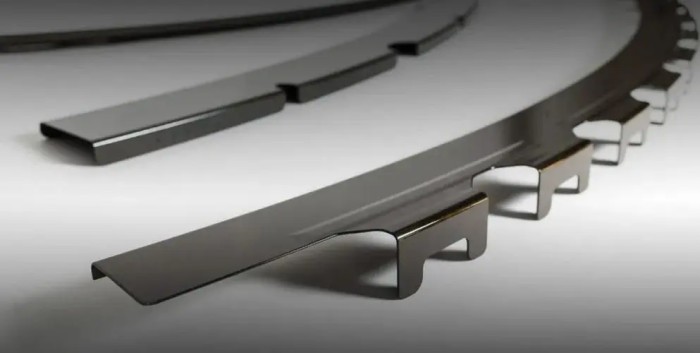
How to grind composite materials?
Step and Slope Grinding
Step grinding: layered accuracy
What is step grinding?
Step grinding is a fine surface treatment method that involves grinding the composite surface layer by layer. The process starts with deeper cuts and gradually progresses to shallower cuts until the desired surface finish and flatness are achieved. This technology is particularly effective for materials requiring high precision and smoothness.
Process
1. Initial assessment: The surface is first evaluated to determine the extent of imperfections and desired finish.
2. Layered Grinding: The grinding process starts with coarse sand to remove important material and defects. As the process continues, finer grits are used to refine the surface.
3. Final Touches: The final stage includes polishing to achieve a mirror-like finish, ensuring the surface meets the required specifications.
Benefit
Accuracy: The layered approach allows for meticulous control of surface finish.
Versatility: Works on a variety of materials including metals, composites and ceramics.
Enhanced flatness: Achieve superior flatness, critical for components requiring tight tolerances.
Slope grind: Consistent slope angle
What is slope grinding?
In contrast, slope grinding focuses on shaping the grade angle of the composite surface to a consistent level. This technology is critical to ensuring a smooth and uniform surface, especially in applications where angular consistency is critical.
Process
1. Surface Assessment: Similar to step grinding, the surface is evaluated to determine areas that need adjustment.
2. Angle Dressing: Set the grinding tool to the desired tilt angle and grind the surface to achieve a consistent finish across the entire area.
3. Final Touches: Final steps may include polishing or additional grinding to ensure a smooth surface.
Benefit
Uniformity: Make sure all angles are consistent, this is critical for fit and function.
Improved aesthetics: Smooth, consistent surface enhances the overall appearance of the component.
Reduced wear: A consistent slope reduces wear on components and extends their service life.

Scope of Application of Step Grinding and Slope Grinding
Step grinding: Ideal for uneven surfaces
Overview
Step grinding is a method of grinding the surface of a composite material layer by layer, starting with deeper cuts and gradually moving to shallower cuts. This technique is particularly effective on surfaces that are uneven or have significant imperfections.
Application scope
1. Heavy material removal: Step grinding is ideal for situations where large amounts of material need to be removed. This is common in the initial stages of machining when rough surfaces need to be smoothed.
2. Complex geometry: Parts with complex shapes or complex designs often require step grinding to achieve the desired surface finish. The layered approach allows precise control of the grinding process, making it suitable for parts of varying thicknesses.
3. High-precision components: Industries such as aerospace and automotive often require high precision in their components. Step grinding can achieve the flatness and surface finish required for critical applications such as turbine blades and engine parts.
4. Repair and Refurbishment: Step grinding is also used for the repair and refurbishment of worn parts. By removing the damaged surface layer, manufacturers can restore the part to its original specifications.
Slope grinding: perfect surface finishing
Overview
Slope grinding, on the other hand, focuses on shaping the slope angle of the composite surface to a consistent level. This technology is primarily used for surface finishing rather than extensive material removal.
Application scope
1. Surface finishing: Bevel grinding is ideal for situations where the surface is relatively flat and only requires finishing. This is common in applications where aesthetics and smoothness are important, such as decorative parts or consumer products.
2. Consistent angle requirements: Parts that require consistent bevel angles (such as molds and dies) benefit from bevel grinding. This ensures that all angles are uniform, which is critical for proper assembly and functionality.
3. Low material removal: If only a small amount of material needs to be removed to achieve the desired finish, bevel grinding is the preferred method. This often occurs during the final stages of machining, where precision and surface quality are crucial.
4. Maintaining tolerances: Bevel grinding is also used in applications where specific tolerances must be maintained. This technology allows fine-tuning without significantly changing the overall dimensions of the component.
Grinding Tools
Step Grinding Tools
1. Grinding Wheel
The grinding wheel is the main tool used in step grinding. These wheels come in a variety of sizes, shapes and grits for material removal versatility.
Coarse grinding wheel: Originally, coarse grinding wheels were used to remove large amounts of material from uneven surfaces. These wheels are designed to handle heavy cutting and grind away imperfections quickly.
Medium to fine grinding wheel: The medium to fine grinding wheel is used to refine the surface as the grinding process progresses. These wheels help achieve the desired flatness and surface finish, transitioning from rough to smooth.
2. Sandpaper
Sandpaper is another important tool in step grinding, especially during the final finishing stages.
Various grit sizes: Sandpaper comes in various grit sizes, from coarse to extra fine. This allows the operator to gradually refine the surface, ensuring a smooth surface.
Flexible backing: Sandpaper with flexible backing conforms to surface contours, making it ideal for achieving an even finish on complex geometries.
3. Surface grinder
Surface grinders are specialized machines designed for precision grinding. They provide a stable platform for graded grinding, ensuring consistent results.
Magnetic suction cups: These machines often use magnetic suction cups to hold the workpiece securely in place, allowing for precise grinding.
Automatic Feeding System: Many surface grinders are equipped with automatic feeding systems that increase efficiency and accuracy during the grinding process.
Slope grinding tool
1. Fineer grinding wheel
Slope grinding requires tools that can precisely adjust the slope angle, thus requiring the use of finer grinding wheels.
Fine grinding wheels: These wheels are designed for surface finishing and are used to achieve smooth, consistent slopes. They remove minimal material while providing a refined finish.
2. Precision sandpaper
Similar to step sanding, sandpaper plays a vital role in grade sanding, but the focus is on the finer grades.
Ultra-fine sandpaper: This type of sandpaper is used to achieve a polished effect on bevel corners. It helps smooth out any rough edges and ensures uniformity.
3. Angle grinder
An angle grinder is a versatile tool that can be used for grade grinding, especially when working on larger surfaces.
Adjustable angle setting: Many angle grinders come with adjustable settings that allow the operator to set a specific grinding angle to suit the slope adjustment.
Various attachments: The angle grinder can accommodate a variety of attachments, including grinding wheels and sanding pads, providing flexibility in the grinding process.
-
Online service
-
Official wechat
account
-
QQ:40933769
-
E-mail:
sales@z-lion.com
Online service
Please feel free to give your inquiry in the form below. We will reply you in 24 hours.

